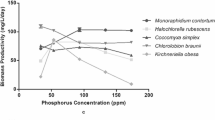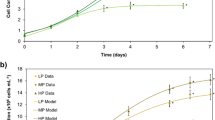Abstract
Biofuels derived from non-crop sources, such as microalgae, offer their own advantages and limitations. Despite high growth rates and lipid accumulation, microalgae cultivation still requires more energy than it produces. Furthermore, invading organisms can lower efficiency of algae production. Simple environmental changes might be able to increase algae productivity while minimizing undesired organisms like competitive algae or predatory algae grazers. Microalgae are susceptible to pH changes. In many production systems, pH is kept below 8 by CO2 addition. Here, we uncouple the effects of pH and CO2 input, by using chemical pH buffers and investigate how pH influences Nannochloropsis salina growth and lipid accumulation as well as invading organisms. We used a wide range of pH levels (5, 6, 7, 8, 9, and 10). N. salina showed highest growth rates at pH 8 and 9 (0.19 ± 0.008 and 0.19 ± 0.011, respectively; mean ± SD). Maximum cell densities in these treatments were reached around 21 days into the experiment (95.6 × 106 ± 9 × 106 cells mL−1 for pH 8 and 92.8 × 106 ± 24 × 106 cells mL−1 for pH 9). Lipid accumulation of unbuffered controls were 21.8 ± 5.8 % fatty acid methyl esters content by mass, and we were unable to trigger additional significant lipid accumulation by manipulating pH levels at the beginning of stationary phase. Ciliates (grazing predators) occurred in significant higher densities at pH 6 (56.9 ± 39.6 × 104 organisms mL−1) than higher pH treatments (0.1–6.8 × 104 organisms mL−1). Furthermore, the addition of buffers themselves seemed to negatively impact diatoms (algal competitors). They were more abundant in an unbuffered control (12.7 ± 5.1 × 104 organisms mL−1) than any of the pH treatments (3.6–4.7 × 104 organisms mL−1). In general, pH values of 8 to 9 might be most conducive to increasing algae production and minimizing invading organisms. CO2 addition seems more valuable to algae as an inorganic carbon source and not as an essential mechanism to reduce pH.



Similar content being viewed by others
References
Abu-Rezq TS, Al-Musallam L, Al-Shimmari J, Dias P (1999) Optimum production conditions for different high-quality marine algae. Hydrobiologia 403:97–107
Arudchelvam Y, Nirmalakhandan N (2012) Energetic optimization of algal lipid production in bubble columns: part 1: evaluation of gas sparging. Biomass Bioenergy 46:757–764
Bartley ML, Boeing WJ, Corcoran A, Holguin FO, Schaub T (2013) Effects of salinity on growth and lipid accumulation of biofuel microalga Nannochloropsis salina and invading organisms. Biomass Bioenergy 54:83–88
Becker EW (1994) Microalgae biotechnology and microbiology. Cambridge University Press, Cambridge
Borowitzka MA (1998) Limits to growth. In: Wong YS, Tam NFY (eds) Wastewater treatment with algae. Springer, Berlin, pp 203–218
Boussiba S, Vonshak A, Cohen Z, Avissar Y, Richmond A (1987) Lipid and biomass production by the halotolerant microalgae Nannochloropsis salina. Biomass 12:37–47
BP (2011) BP statistical review of world energy. British Petroleum. http://www.bp.com/sectionbodycopy.do?categoryId=7500&contentId=7068481. Accessed March 9, 2011.
Brennan L, Owende P (2010) Biofuels from microalgae—a review of technologies for production, processing, and extractions of biofuels and co-products. Renew Sust Energ Rev 14:557–577
Brown MR, Garland CD, Jeffrey SW, Jameson ID, Leroi JM (1993) The gross and amino acid compositions of batch and semi-continuous cultures of Isochrysis sp. (clone T. ISO), Pavlova lutheri and Nannochloropsis oculata. J Appl Phycol 5:285–296
Cheng-Wu Z, Zmora O, Kopel R, Richmond A (2001) An industrial-size flat plate glass reactor for mass production of Nannochloropsis sp. (Eustigmatophyceae). Aquaculture 195:35–49
Chi Z, O’Fallon JV, Chen S (2011) Bicarbonate produced from carbon capture for algae culture. Trends Biotechnol 29:537–541
Chini Zittelli G, Pastorelli R, Tredici MR (2000) A modular flat panel photobioreactor (MFPP) for indoor mass cultivation of Nannochloropsis sp. under artificial illumination. J Appl Phycol 12:521–526
Chini Zittelli G, Rodolfi L, Tredici MR (2003) Mass cultivation of Nannochloropsis sp. in annular reactors. J Appl Phycol 15:107–114
Chisti Y (2007) Biodiesel from microalgae. Biotechnol Adv 25:294–306
Das P, Aziz SS, Obbard JP (2011) Two phase microalgae growth in the open system for enhanced lipid productivity. Renew Energ 36:2524–2528
Doan TTY, Sivaloganathan B, Obbard JP (2011) Screening of marine microalgae for biodiesel feedstock. Biomass Bioenergy 35:2534–2544
Franchino M, Comino E, Bona F, Riggio VA (2013) Growth of three microalgae strains and nutrient removal from an agro-zootechnical digestate. Chemosphere 92:738–744
Giordano M, Beardall J, Raven JA (2005) CO2 concentrating mechanisms in algae: mechanisms, environmental modulation, and evolution. Annu Rev Plant Biol 56:99–131
Griffiths MJ, Harrison SL (2009) Lipid productivity as a key characteristic for choosing algal species for biodiesel production. J Appl Phycol 21:493–507
Guillard RRL, Ryther JH (1962) Studies of marine planktonic diatoms. I. Cyclotella nana Hustedt and Detonula confervacea Cleve. Can J Microbiol 8:229–239
Hsu J (1996) Multiple comparisons: theory and methods. Chapman & Hall, London
Huang XX, Huang ZZ, Wen W, Yan JQ (2013) Effects of nitrogen supplementation of the culture medium on the growth, total lipid content and fatty acid profiles of three microalgae (Tetraselmis subcordiformis, Nannochloropsis oculata and Pavlova viridis). J Appl Phycol 25:129–137
James SC, Janardhanam V, Hanson DT (2013) Simulating pH effects in an algal-growth hydrodynamics model. J Phycol 49:608–615
Karl TR, Melino JM, Peterson TC (2009) Global climate change impacts in the United States. Cambridge University Press, Cambridge
Leakey RJG, Burkill PH, Sleigh MA (1994) A comparison of fixatives for the estimation of abundance and biovolume of marine planktonic ciliate populations. J Plankton Res 16:375–389
Maberly SC, Ball LA, Raven JA, Sultemeyer D (2009) Inorganic carbon acquisition by Chrysophytes. J Phycol 45:1052–1061
Mata TM, Martins A, Caetano NS (2010) Microalgae for biodiesel production and other applications: a review. Renew Sust Energ Rev 14:217–232
Menke S, Sennhenn A, Sachse JH, Majewski E, Huchzermeyer B, Rath T (2012) Screening of microalgae for feasible mass production in industrial hypersaline wastewater using disposable bioreactors. Clean-Soil Air Water 40:1401–1407
Moazami N, Ashori A, Ranjbar R, Tangestani M, Eghtesadi R, Nejad AS (2012) Large-scale biodiesel production using microalgae biomass of Nannochloropsis. Biomass Bioenergy 39:449–453
Moheimani NR (2013) Inorganic carbon and pH effect on growth and lipid productivity of Tetraselmis suecica and Chlorella sp (Chlorophyta) grown outdoor in bag photobioreactors. J Appl Phycol 25:387–398
Moheimani NR, Borowitzka MA (2011) Increased CO2 and the effect of pH on growth and calcification of Pleurochrysis carterae and Emiliania huxleyi (Haptophyta) in semicontinuous cultures. Appl Microbiol Biot 90:1399–1407
Patil P, Reddy H, Muppaneni T, Mannarswamy A, Holguin O, Schaub T, Nirmalakhandan N, Cooke P, Deng S (2012) Power dissipation in microwave-enhanced in-situ transesterification of algal biomass to biodiesel. Green Chem 14:809
Price GD, Badger MR, Woodger FJ, Long BM (2008) Advances in understanding the cyanobacterial CO2-concentrating mechanism (CCM): functional components, Ci transporters, diversity, genetic regulation and prospects for engineering into plants. J Exp Bot 59:1441–1461
Rebolloso-Fuentes MM, Navarro-Perez A, Garćia-Camacho F, Ramos-Miras JJ, Guil-Guerrero JL (2001) Biomass nutrient profiles of the microalga Nannochloropsis. J Agric Food Chem 49:2966–2972
Richmond A, Becker EW (1986) Technological aspects of mass cultivation—a general outline. In: Richmond A (ed) CRC handbook of microalgal mass culture. CRC, Boca Raton, pp 245–264
Richmond A, Cheng-Wu Z (2001) Optimization of a flat plate glass reactor for mass production of Nannochloropsis sp. outdoors. J Biotechnol 85:259–269
Richmond A, Lichtenberg E, Stahl B, Vonshak A (1990) Quantitative assessment of the major limitations on the productivity of Spirulina platensis in open raceways. J Appl Phycol 2:195–206
Rocha J, Garcia JEC, Henriques MHF (2003) Growth aspects of the marine microalga Nannochloropsis gaditana. Biomol Eng 20:237–242
Rodolfi L, Chini Zittelli G, Bassi N, Padovani G, Biondi N, Bonini G, Tredici MR (2008) Microalgae for oil: strain selection, induction of lipid synthesis and outdoor mass cultivation in a low-cost photobioreactor. Biotechnol Bioeng 102:100–112
Roessler PG (1990) Environmental control of glycerolipid metabolism in microalgae: commercial implications and future research directions. J Phycol 26:393–399
SevrinReyssac J, Blier R, Dumas A, Ouelette Y (1996) Intensive microalgae cultures integrated in an experimental lagooning recycling swine manure. Ann Biol 35:41–68
Sigala J, Unc A (2012) A PCR–DGGE approach to evaluate the impact of wastewater source on the antibiotic resistance diversity in treated wastewater effluent. Water Sci Technol 65:1323–1331
Spolaore P, Joannis-Cassan C, Duran E, Isambert A (2006) Optimization of Nannochloropsis oculata growth using the response surface method. J Chem Technol Biotechnol 81:1049–1056
Stoecker DK, Gifford DJ, Putt M (1994) Preservation of marine planktonic ciliates—losses and cell shrinkage during fixation. Mar Ecol Prog Ser 110:293–299
Sukenik A, Zmora O, Carmeli Y (1993) Biochemical quality of marine unicellular algae with special emphasis on lipid composition. II. Nannochloropsis sp. Aquaculture 117:313–326
Tufvesson LM, Lantz M, Borjesson P (2013) Environmental performance of biogas produced from industrial residues including competition with animal feed—life-cycle calculations according to different methodologies and standards. J Cleaner Prod 53:214–223
Van Wagenen J, Miller TW, Hobbs S, Hook P, Crowe B, Huesemann M (2012) Effects of light and temperature on fatty acid production in Nannochloropsis salina. Energies 5:731–740
Wang B, Li Y, Wu N, Lan C (2008) CO2 bio-mitigation using microalgae. Appl Microbiol Biot 79:707–718
Wang ZT, Ullrich N, Joo S, Waffenschmidt S, Goodenough U (2009) Algal lipid bodies: stress induction, purification, and biochemical characterization in wild-type and starchless Chlamydomonas reinhardtii. Eukaryot Cell 8:1856–1868
Weisse T, Stadler P (2006) Effects of pH on growth, cell volume, and production of freshwater ciliates, and implications for their distribution. Limnol Oceanogr 51:1708–1715
Yamasaki S, Hirata H (1995) CO2 concentration change in Nannochloropsis sp. culture medium. Aquacult Eng 14:357–365
Acknowledgments
We are grateful for the valuable work from the following undergraduate students: Herman Campos, Levi Chavez, Renee Pardee, Herberto Chaparro, and Zach Brecheisen. Darren James provided valuable help with statistical analyses for this research. This work is supported by the U.S. Department of Energy under contract DE-EE0003046 awarded to the National Alliance for Advanced Biofuels and Bioproducts. This is a New Mexico Agricultural Experiment Station publication, supported by state funds and the U.S. Hatch Act.
Author information
Authors and Affiliations
Corresponding author
Rights and permissions
About this article
Cite this article
Bartley, M.L., Boeing, W.J., Dungan, B.N. et al. pH effects on growth and lipid accumulation of the biofuel microalgae Nannochloropsis salina and invading organisms. J Appl Phycol 26, 1431–1437 (2014). https://doi.org/10.1007/s10811-013-0177-2
Received:
Revised:
Accepted:
Published:
Issue Date:
DOI: https://doi.org/10.1007/s10811-013-0177-2




